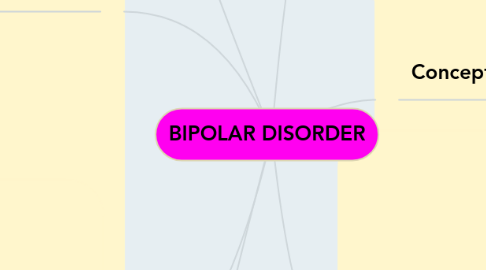
1. Symptoms
1.1. • Manic episode
1.1.1. i) Feel very “up”, “high”, or elated
1.1.2. ii) Have a lot of energy
1.1.3. iii) Have increased activity levels
1.2. • Depressive episode
1.2.1. i) Feel very sad, down, empty, or hopeless
1.2.2. ii) Have very little energy
1.2.3. iii) Have decreased activity levels
2. Theories
2.1. • Cognitive
2.1.1. 1) Factors:
2.1.1.1. Always think about drawback characteristics of themselves.
2.1.1.2. Always use negative viewpoint to attest the negative think about themselves.
2.1.1.3. Always dissapointed about future
2.1.2. 2) Cognitive wrong
2.1.2.1. Negative glorify
2.2. • Treatment
2.2.1. 1) Strategy and skill
2.2.1.1. Physicotherapeutics
2.2.1.2. Biotherapy
2.2.1.3. Manual Intervention
2.2.2. 2) Set up cooperation relationship
2.2.2.1. Physician-patient relations
2.2.3. 3) Family cooperation
2.2.3.1. Degree of attentiveness
2.2.3.2. Actively guide
2.2.3.3. Daily maintenance
2.2.3.4. Communication
3. Impacts
3.1. • Lack of awareness.
3.1.1. Leading most to conclude that it is a different mental illness altogether.
3.2. • Inability to detect or recognize symptoms.
3.2.1. Early symptoms are frequently ignored and/or wrongly attributed to other
3.3. • Social Isolation.
3.3.1. Minimising the individual’s opportunities to receive support during times of need.
3.4. • Breakdown of relationship.
3.4.1. Relationships leading to reported high levels of divorce and separation from family and friends.
4. Treatments
4.1. • Bipolar disorder treatment best to be guided by psychiatrist (skilled in bipolar disorder), psychologist, social worker and also psychiatric nurse.
4.2. • The medications used to treat bipolar disorder may include mood stabilizers, antipsychotics, antidepressants, antidepressant-antipsychotic, anti-anxiety medications.
5. Definition
5.1. • Formerly called as manic depression.
5.2. • Causes unusual shifts in mood, energy, activity levels, and ability to carry out day-to-day tasks.
5.3. • These moods range from periods of extremely “up” - energizer behavior (manic episodes) to very “down” - hopeless periods (depressive episodes).
5.4. • The less severe manic periods are known as hypomanic episodes.
5.5. • Mood shifts mat occur only a few times a year.
6. Concepts
6.1. • Hope
6.1.1. To experience long periods of wellness.
6.2. • Perspective
6.2.1. Difficult to believe things will get better, it is important not to give up hope.
6.3. • Personal Responsibility
6.3.1. take action to keep moods stabilized.
6.4. • Education
6.4.1. To make informed decisions about all aspects of life and treatment.
6.5. • Support
6.5.1. To maintaining stability and enhancing the quality of life.
7. Causal Factors
7.1. • The exact cause of bipolar disorder in unknown.
7.2. • Factors:
7.2.1. 1) Biological differences - Appear to have physical changes in their brains.
7.2.2. 2) Neurotransmitters - Imbalance of neurotransmitter seems play a significant role.
7.2.3. 3) Inherited traits - More common in people who have a first-degree relative, such as sibling or parent, with the condition.
